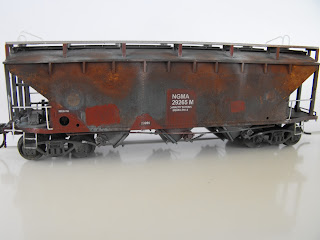Hi all,
For my first blog I have some locomotive photos taken on the Bowen Creek layout.
For my first blog I have some locomotive photos taken on the Bowen Creek layout.
The weathering is a mix of washes and powders. On almost all my models, the weathering is done in this manner. When weathering, I rarely use an airbrush. The washes and powders technique gives greater control than an air brush, and allows you to target smaller areas of the model.
I feel that even with the best double action airbrush, the models just look over weathered. However I still use an airbrush for exhaust, soot, and under body grime in small, thin doses!
For
my next blog, I'll take a look at a "44" class with extreme weathering,
using a very interesting technique. Until then, I hope sharing my
photo's with you all, assists in your weathering ideas.
Deano












